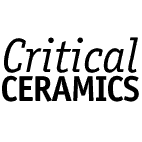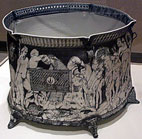




Forrest J. Snyder
I approached Ed Eberle’s exhibition “Drawings on Paper and Porcelain” (Columbus Museum of Art, January 16 - March 21, 1999) without great forethought or knowledge about what I was about to see. Sure, I’d seen a couple of pots by Mr. Eberle at some point, but I had never studied them. What I did know were minimal facts. He had been awarded his MFA from the NYSCC at Alfred University and had taught at the Philadelphia College of Art and Carnegie Mellon University. Other than this, I knew nothing.
What I encountered in the gallery was an artist of exceptional vision. At first, I could hardly look at the pottery on display. His work was apparently so far from my realm of understanding that I almost gave up and left. “Ed Eberle speaks in tongues,” I thought. However, I forced myself to stay and really look at the pottery, turning to the easier abstract drawings when I needed a rest. Shortly, I began to recognize architectural motifs both in form and on surface; I saw familiar, or at least not unknown, geometric patterns, symbolic references to the Fibonacci series, Byzantine priests from and Asian monks, beautiful naked torsos, fish, goats, and birds.
Let me begin with the pots themselves. Alone, these forms would be quite astonishing. They’re thrown and altered porcelain vessels; they are clearly vessels, boasting uplifting feet and delicate handles. Many of the lids are double layered, one close fitting thrown flower of an inverted bowl fitting within another. The outer lids often ending in a peak or terraced knob.
As my vision began to include the vessels as architecture, suddenly my view opened up to encompass the gallery itself as vessel. A vessel holding me and others captive. I couldn’t help but smile. Mr. Eberle had managed to loop my mind from art to architecture and back again. These pots transformed into full bodied four and six sided buildings, the handles and feet now architectural details - dentils and decorative podiums; the lids stylish roofs complete with cornice and moldings. Not insignificantly, these buildings incorporated references beyond the familiar architecture known to me. These walls and roof lines hinted at medieval European, African, and Far Eastern buildings.
Granted these forms are super by themselves, but Eberle goes beyond expectation and fills the surface with intricate black on white line drawings of human figures, animals, geometric patterns, and religious and psychological symbology. Clearly, these just are not simply studies or surface treatments. The drawings are as important, but no more so, than the forms themselves. Neither can be dismissed lightly. Eberle conveys that these are drawings of necessity. In other words, through the very feeling of the line quality, body language, and facial expressions, I know that these are drawings of need, of compulsion. Indeed, these people are not thoughtless decoration; they are the occupants of these buildings, these homes, the passers by on ancient cobbled streets, the denizens of a land as real as our own.
The figure and ground reference to Greek Atticware provided an easy “in” to these streets, as do the titles of some of the pieces - “Eros II“, “Coniunctio”. However, unlike any Greek artisan, Eberle has managed, seemingly without struggle, to render his figures fully in three dimensions. Furthermore, figures overlap, creating active foregrounds and backgrounds. Finally, these figures are extraordinary for they exist in multiple points of perspective without fighting with their neighbors. Gladly, there is room for every last one of them. There’s no need to push and shove on these streets. What an altruistic people Eberle has begot! It all works. Pot. Building. Lid. Roof. Figures. Occupants. Nothing is a miss. All is solidly anchored in this world.
What of this world? Certainly, it is a complex and in many ways a largely wondrous place. Beast and man roam the streets in search of...? Holy men appear around corners. They sign. To bless? To exorcise some evil? Each person, every last one, appears preoccupied with their own immediate concern. Although surrounded by like comrades, each person ventures forth alone, silently intent on their quest. I am at a loss to explain their preoccupations; I can only say for certain that no one appears tortured. They’re seriously contemplative, sure, but not hysterically troubled. Perhaps Mr. Eberle has commented so well on my own existence that I fail to recognize it as such.
Throughout these works, as complex and layered as they are, Edward Eberle has presented one overriding distinctive quality - his personal truth. When recognized as such, and it is difficult not to, these truths become universal. Not understood precisely, but true none the less. Indeed, it is this unkenned discovery that compels me to value this work so highly.


